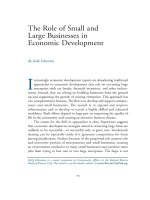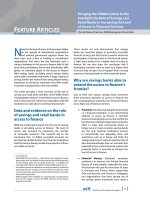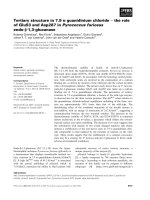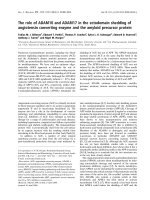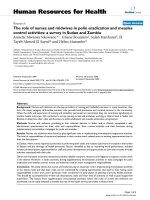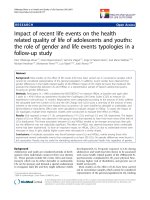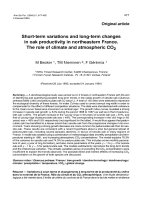Tasks in action in Vietnamese EFL high school classrooms- The role of rehearsal and performance in teaching and learning through oral tasks
Bạn đang xem bản rút gọn của tài liệu. Xem và tải ngay bản đầy đủ của tài liệu tại đây (2.31 MB, 343 trang )
Tasks in action in Vietnamese EFL high school classrooms: The role
of rehearsal and performance in teaching and learning through oral
tasks
By
NGUYEN THI BAO TRANG
A thesis submitted to Victoria University of Wellington
in fulfilment of the requirements for the degree of Doctor of Philosophy
in Applied Linguistics
Victoria University of Wellington, New Zealand
2013
iii
ACKNOWLEDGEMENTS
This PhD work had been, for me, a process of fruitful discovery and learning. It would not
have reached completion without the support of the people whom I thank below.
I owe profound gratitude to my supervisors, Dr Jonathan Newton and Associate Professor
David Crabbe not only for their critical minds, thoughtful guidance and insightful feedback
but also for their kindness and encouragement throughout these years of study. Without
their assistance, this thesis would not have been possible.
I am especially indebted to NZAID for granting me a doctoral scholarship to pursue this
study. I wish to thank the NZAID advisers at Victoria University of Wellington, in
particular, Inge de Leeuw, Julia Harrison, and Linsell Richards for their kindness and
support.
I would also like to express my heartfelt thanks to the Vietnamese teachers and students
who participated in my research for their generous time and trust. I sincerely thank the
Department of Education and Training, the Head of the school and teaching staff of the
school back home in Vietnam for their support and encouragement during my data
collection.
I am grateful to the staff at the School of Linguistics and Applied Language Studies (LALS)
and Victoria University for creating a supportive and friendly academic environment,
which played a nurturing and facilitating role in my research. Special thanks go to Bernie
Hambleton, Janet Attrill and Anna Adams for their administrative assistance. I also thank
Professor Laurie Bauer, Associate Professor Paul Warren, Dr John Macalister, Dr Stuart
Webb, Dr Elaine Vine, Professor Janet Holmes, Dr Jean Parkinson and Dr Angela Joe for
the kindness and moral support they offered.
My sincere thanks also go to: Dr Dalice Sim, Statistical Consultant at Victoria for help with
statistical analysis; Dr Stuart Webb for letting me audit his Research Methods classes;
Tony Quin for assistance with resources and Endnote references; Kirsten Reid for her
valuable advice on my oral presentation skills; Dr Xiaodan Gao and again Kirsten Reid for
their useful advice on my writing earlier and later respectively in the thesis writing
process; Dr Dennis Dawson for helpful advice on graphs and figures; Laila Faisal for useful
iv
suggestions on thesis formatting; Chris Mahoney for allowing me to observe her English
Proficiency Programme class, which was my first valuable classroom observation
apprenticeship; and Beth Thomas for proofreading my thesis.
I also thank the Faculty of Humanities and Social Sciences at Victoria and NZAID for
providing me with grants to carry out data collection in Vietnam and attend conferences.
I am thankful to my varying office mates, Lauren, Dhu, Steve and Jemma, my task-based
research group and my LALS PhD group for their research stories. I also thank my
Vietnamese friends in Wellington for their friendship and kindness.
Last but not least, I thank my husband, Khiếu, for his mind of science, his own PhD
experience and his continued understanding and patience, which in many ways, played a
role in my research. I particularly thank my son, Hạo Nhiên and my daughter, Trạm Nhiên
for being with me throughout the years. I deeply thank my parents and my parents-in-law
for encouraging and supporting me to pursue this PhD study. I dedicate this work to them
for their unfailing love during these times and always.
v
ABSTRACT
Task-based language teaching (TBLT) has attracted considerable attention in research on
language teaching and learning. Numerous publications have made a case for TBLT and
the role of tasks in learning. TBLT has been introduced in language curricula around the
world, including English as a foreign language (EFL) curricula in many countries in Asia. Yet
research into tasks in action from both teaching and learning perspectives is rare with
scant examination of decisions on task design and implementation that teachers make in
the classroom and how their pedagogical decisions are linked to student learning and
engagement. The present research addresses these gaps.
The research was conducted in two phases in a Vietnamese high school where a series of
task-based EFL textbooks have been adopted to promote curriculum innovation. Phase 1
was a descriptive study which investigated how the Vietnamese EFL teachers
implemented oral textbook tasks through adapting task design and creating classroom
activity and how learners engaged in the tasks. The data were collected over two and a
half months through classroom observations, stimulated recalls and in-depth interviews
with teachers and students. The results revealed that the teachers displayed a strong
tendency to adapt or replace the textbook tasks, with specific preferences for open over
closed tasks, input-independent over input-dependent tasks and divergent over
convergent tasks. They also opted for tasks that are not just ‘real world’, but ‘real’ to
students. Teacher task choices were found to be guided by their own task
experimentation, by clearly articulated beliefs about teaching and learning and by a
strong orientation to learner engagement.
Decision making by all the teachers reflected a general commitment to a final public
performance of the task by groups of students. This public performance was preceded by
rehearsal for the performance, involving students doing the task in pairs or groups to
prepare for the performance of the task in front of the class. The terms rehearsal and
performance were used because they captured the teachers’ and students’ orientation
and intent as observed in the lessons and explained in the interviews. Rehearsal and
performance constituted two of four identifiable stages of task implementation used by
the teachers: pre-task, rehearsal, performance and post-task. Both the teachers and
vi
students valued the notion of performance as a driving force for the use of English and as
a social classroom event to engage students in task work. The centrality of public
performance in these EFL classrooms, and a lack of empirical evidence about its impact in
task-based learning motivated Phase 2 of the thesis.
Phase 2 specifically addressed the impact of task design and learner proficiency on the
occurrence and resolution of language-related episodes (LREs) (Swain, 1998) in task
rehearsal and on the subsequent take-up in the public performance of the language items
which were focussed on in LREs. Three proficiency groups (n=8 dyads in each) from six
intact classes carried out two tasks: one problem-solving task (a convergent task) and one
debate task (a divergent task), with a 15-minute rehearsal for their performance. The first
group was composed of dyad members of the same higher proficiency (HH); the second
group consisted of mixed proficiency dyads (HL) and the third group was lower
proficiency dyads (LL). The total data included 48 rehearsals and 48 corresponding
performances collected in normal classroom hours. Students were also interviewed after
they had finished all the tasks.
The results showed that task design and proficiency affected not only the occurrence and
resolution of LREs in task rehearsal but also uptake in the public performance.
Specifically, while the problem-solving task induced more LREs, the debate task was more
conducive to uptake because the latter task, from the students’ perspective, lent itself to
performance in ways that the former did not. Overall lower proficiency dyads produced
more LREs in rehearsal than higher proficiency dyads. However, it was how LREs were
resolved rather than the frequency of LREs that correlated positively with successful
uptake in performance. Proficiency also influenced the problem-solving strategies that
the learners adopted to prepare for the public performance.
Taken as a whole, this thesis suggests that teacher thinking plays an essential role in
transforming tasks in classrooms, and that building in performance to tasks and rehearsal
for that performance may contribute to language learning and development. The
research has useful implications for task design and implementation, as well as for theory
and research methodology.
vii
TABLE OF CONTENTS
ACKNOWLEDGEMENTS iii
ABSTRACT v
TABLE OF CONTENTS vii
LIST OF TABLES xiv
LIST OF FIGURES xv
ABBREVIATIONS USED IN THE THESIS xvii
TRANSCRIPTION SYMBOLS USED IN THE THESIS xviii
Chapter 1 INTRODUCTION 1
1.1 Introduction 1
1.2 Research context 2
1.3 Overview of the research 4
1.4 Significance of the research 5
1.5 Organisation of the research 6
Chapter 2 LITERATURE REVIEW 1: TASK-BASED LANGUAGE TEACHING, TASKS, FOCUS ON FORM
AND CLASSROOM TASK IMPLEMENTATION 7
2.1 Introduction 7
2.2 TBLT 7
2.3 Defining tasks 9
2.3.1 Task as learning goal 10
2.3.2 Task as teaching/learning activity 12
2.4 Focus on form in TBLT 13
2.4.1 A psycholinguistic approach 13
2.4.2 A socio-cultural approach 16
2.4.3 A cognitive approach 21
2.4.4 Summary: Focus on form approaches in TBLT 23
2.5 Classroom task implementation 24
2.6 Summary and link to the Phase 1 study 28
viii
Chapter 3 LITERATURE REVIEW 2: REHEARSAL, PUBLIC PERFORMANCE, LANGUAGE-RELATED
EPISODES (LREs) AND L2 LEARNING 31
3.1 Introduction 31
3.2 Pre-task planning 31
3.2.1 Strategic planning 32
3.2.2 Rehearsal 33
3.3 Public performance 36
3.4 LREs & L2 learning 38
3.4.1 LREs & FFEs 38
3.4.2 Focus-on-form episodes (FFEs) and L2 learning 39
3.4.3 LREs and L2 learning 41
3.4.3.1 LREs and L2 learning measured by tailor-made post-tests 42
3.4.3.2 LREs and L2 learning measured by subsequent written performance 45
3.4.3.3 LREs and L2 learning measured by subsequent oral performance 47
3.5. Task types and LREs 49
3.5.1 Task types and negotiation of meaning 49
3.5.2 Task types and LREs 51
3.6 Proficiency and LREs 54
3.7 The linguistic focus of LREs and L2 learning 57
3.8 Summary and link to the Phase 2 study 58
Chapter 4 THE PHASE 1 STUDY: METHODOLOGY 61
4.1 Introduction 61
4.2 The research site 62
4.3 The teacher and student participants 62
4.4 Data collection methods 65
4.4.1 Classroom observation 66
4.4.1.1 Multiple case studies 67
4.4.1.2 Video recordings 68
4.4.1.3 Audio recordings 69
ix
4.4.1.4 Field notes and classroom materials 69
4.4.2 Stimulated recall and in-depth interviews with the teachers 69
4.4.3 Stimulated recall focus group interviews with students 72
4.4.4 Summary of data collection methods for Phase 1 73
4.5 Data collection procedures 74
4.5.1 Ethics 74
4.5.2 Piloting 75
4.5.3 Main data collection 76
4.5.4 Summary of data collection procedures 76
4.6 Data analysis 77
4.6.1 Analysing the teachers’ use of textbook tasks 78
4.6.1.1 How closely the teachers followed the textbooks 78
4.6.1.2 Task design features 80
4.6.2 Analysing the teachers’ procedures of task implementation 88
4.6.3 Analysing the interview data 89
4.6.4 Analysing the learners’ task-based interaction data 91
4.6.4.1 The data set 91
4.6.4.2 Coding LREs in rehearsal and uptake in performance 91
4.6.4.3 Coding amounts of L1 and L2 use 92
4.7 Validity and reliability 93
4.7.1 Validity 93
4.7.2 Reliability 95
4.8 Summary 95
Chapter 5 THE PHASE 1 STUDY: HOW THE TEACHERS IMPLEMENTED TEXTBOOK TASKS 97
5.1 Introduction 97
5.2 How closely did the teachers follow the textbook tasks? 97
5.3 In what ways did the design features of the teachers’ tasks diverge from the textbook
tasks, and why did they diverge from them? 98
x
5.3.1 In what ways did the design features of the teachers’ tasks diverge from the
textbook tasks? 98
5.3.2 Why did the teachers diverge from the textbook tasks? 100
5.3.2.1 Open-ended tasks 102
5.3.2.2 Authentic tasks 105
5.4 What task implementation procedures did the teachers use, and why did they use them?
110
5.4.1 Pre-task 110
5.4.1.1 The teachers’ pre-task work 111
5.4.1.2 The teachers’ rationales for pre-task work 113
5.4.1.3 Students’ perceptions of the learning opportunities offered in the pre-task work
119
5.4.1.4 Pre-task work: Concluding remarks 122
5.4.2 During-task: Rehearsal-performance 123
5.4.3 Post-task 128
5.4.4 Rehearsal-Performance: Concluding remarks 129
5.5 Summary of the chapter 132
Chapter 6 THE PHASE 1 STUDY: HOW THE STUDENTS ENGAGED IN TASKS 133
6.1 Introduction 133
6.2 To what extent did the Vietnamese high school students attend to form while
rehearsing for the performance of communicative tasks? If so, how? 133
6.3 To what extent and for what purpose did the students use L1 in task rehearsal? 135
6.4 To what extent did the students use items accurately in performance that had been
subject to LREs in rehearsal? 141
6.5 How did the students perceive communicative tasks, task rehearsal and performance?
143
6.6 Summary of the chapter 148
Chapter 7 THE PHASE 2 STUDY: METHODOLOGY 149
7.1 Introduction 149
7.2 Research questions 149
7.3 Student participants 150
xi
7.3.1 Proficiency 150
7.3.2 Gender 152
7.4 The tasks 153
7.4.1 Task topic 153
7.4.2 Task type 154
7.5 Study design 156
7.6 Data collection procedures 159
7.6.1 Ethics 159
7.6.2 Briefings with the teachers 160
7.6.3 The practice sessions 160
7.6.4 Piloting 161
7.6.5 The main data collection 162
7.6.5.1 Rehearsal 162
7.6.5.2 Performance 163
7.6.5.3 Student interviews 164
7.7 Data analysis 164
7.7.1 The data set 164
7.7.2 Coding LREs in task rehearsal 164
7.7.3 Coding the linguistic focus of LREs 168
7.7.3.1 Lexical LREs 169
7.7.3.2 Grammatical LREs 171
7.7.4 Coding resolutions of LREs 173
7.7.4.1 Correctly solved LREs 173
7.7.4.2 Incorrectly solved LREs 174
7.7.4.3 Unsolved LREs 175
7.7.5 Coding uptake in task performance 177
7.7.5.1 The meaning of uptake in the current study 177
7.7.5.2 The process-product approach 178
7.7.5.3 Coding uptake 179
7.7.6 Inter-coder reliability 188
xii
7.7.7 Statistical analysis 190
7.7.8 Qualitative analysis 191
7.8 Validity and reliability 191
7.8.1 Validity 191
7.8.2 Reliability 192
7.9 Summary 193
Chapter 8 THE PHASE 2 STUDY: LRES IN TASK REHEARSAL 195
8.1 Introduction 195
8.2 Findings 195
8.2.1 Did tasks and proficiency impact on the occurrences of LREs in task rehearsal? 195
8.2.2 How did Vietnamese EFL high school learners resolve language problems in task
rehearsal? 201
8.2.3 Did task type and proficiency affect how LREs were resolved in task rehearsal? 203
8.2.4 Did the linguistic focus of LREs affect how learners resolved them in task rehearsal?
206
8.3 Discussion 212
8.3.1 Rehearsal and task effects on LRE occurrences and resolutions 213
8.3.2 Rehearsal and proficiency effects on LRE occurrences and resolutions 219
8.3.3 Rehearsal and the effects of linguistic focus of LREs on LRE resolutions 223
8.4 Summary 228
Chapter 9 THE PHASE 2 STUDY: UPTAKE IN TASK PERFORMANCE 231
9.1 Introduction 231
9.2 Findings 231
9.2.1 To what extent did learning opportunities operationalised as LREs in rehearsal lead
to uptake in performance? Did task type and proficiency impact on the level of
uptake? 231
9.2.2 Did task type and proficiency affect different types of uptake in task performance? .
235
9.2.3 What was the relationship between LRE resolutions in task rehearsal and uptake in
task performance? 241
xiii
9.2.4 Did uptake in task performance differ by linguistic focus? 245
9.3 Discussion 252
9.3.1 Task effects on uptake 252
9.3.2 Proficiency effects on uptake 257
9.3.3 Relationship between LRE resolutions and uptake 261
9.3.4 The linguistic focus of LREs and uptake 267
9.3.5 Problem-solving strategies: Proficiency and performance pressure 269
9.4 Summary 275
Chapter 10 SUMMARY, IMPLICATIONS AND CONCLUSIONS 277
10.1 Introduction 277
10.2 Summary of findings 277
10.2.1 Phase 1 277
10.2.2 Phase 2 279
10.3 Pedagogical implications 280
10.3.1 Task design 280
10.3.2 Task implementation 282
10.3.2.1 Forms of performance 283
10.3.2.2 Student pairing 284
10.3.2.3 Pre-task and post-task work 285
10.3.2.4 Teacher thinking 286
10.3.2.5 Language development 287
10.4 Methodological implications 288
10.4.1 Research design 288
10.4.2 Data analysis 288
10.5 Theoretical implications 290
10.6 Limitations and future research directions 291
10.7 Contextual reflection 294
10.8 Personal reflection 295
xiv
REFERENCES 297
APPENDICES 325
LIST OF TABLES
TABLE 2.1: Task definitions 9
TABLE 3.1: Willis’s (1996) task-based framework (p.52) 36
TABLE 3.2: Skehan’s (1996a) task-based framework (p.54) 37
TABLE 3.3: LREs and language learning by various measures 42
TABLE 3.4: Swain & Lapkin’s (2002) study design 46
TABLE 4.1: The teacher and class participants 64
TABLE 4.2: Classroom observation scheme 67
TABLE 4.3: Summary of data collection methods 74
TABLE 4.4: Coding teachers’ use of oral tasks from the textbooks 78
TABLE 4.5: Features of task design modified by the teachers 81
TABLE 5.1: Teacher use of (oral) textbook tasks 98
TABLE 5.2: Design features of textbook and teacher tasks 99
TABLE 5.3: The socio-affective flavour in the nine teachers’ talking about tasks 101
TABLE 5.4: Teacher action in the pre-task phase 112
TABLE 5.5: Locating public performance (adapted from Skehan, 2007b, p.61) 124
TABLE 6.1: Occurrences of LREs 133
TABLE 6.2: Amounts of L1 and L2 use by turn in task rehearsal 136
TABLE 6.3: Amounts of L1 and L2 use by word in task rehearsal 136
TABLE 7.1: Proficiency groups and gender 153
TABLE 7.2: Design of the study 157
TABLE 7.3: A sample of reliability data for coding LRE resolutions 189
TABLE 7.4: Reliability results 190
xv
TABLE 8.1: LREs by task and proficiency 196
TABLE 8.2: Summary of the RM ANOVA results on LREs across task type, linguistic focus and
proficiency 198
TABLE 8.3: LRE resolutions by task and proficiency 201
TABLE 8.4: Summary of the RM ANOVA results for LRE resolutions 203
TABLE 8.5: LRE resolution by linguistic focus 207
TABLE 8.6: Summary of the RM ANOVA results for LRE resolutions by linguistic focus and
proficiency 209
TABLE 8.7: Individual data for the HL dyads 222
TABLE 9.1: Total uptake across tasks and proficiency groups 232
TABLE 9.2: Summary of the RM ANOVA results for the total uptake in task performance 234
TABLE 9.3: Uptake types in task performance by task and proficiency 236
TABLE 9.4: Summary of the RM ANOVA results for uptake types in task performance 238
TABLE 9.5: Summary of correlation results for LRE resolutions by task 242
TABLE 9.6: Percentages of unsuccessful uptake out of correctly solved LREs 243
TABLE 9.7: Percentages of successful uptake out of correctly resolved LREs 244
TABLE 9.8: Percentages of incorrect uptake out of incorrectly solved LREs 245
TABLE 9.9: Uptake types by linguistic focus across proficiency groups 246
TABLE 9.10: Summary of the RM ANOVA results for uptake types across linguistic focus and
proficiency 248
TABLE 10.1: Teacher use and implementation of textbook tasks 278
LIST OF FIGURES
FIGURE 4.1: Summary of data collection procedures 77
FIGURE 5.1: Design features of textbook and teacher tasks 100
FIGURE 5.2: Task implementation procedures by the teachers 110
FIGURE 7.1: Procedures for selecting proficiency groups 152
FIGURE 7.2: The scheme for coding uptake in task performance 181
xvi
FIGURE 8.1: LREs cross tasks and proficiency groups 197
FIGURE 8.2: LREs by task, proficiency and linguistic focus 200
FIGURE 8.3: LRE resolutions across tasks and proficiency groups 202
FIGURE 8.4: Correctly solved LREs by task and proficiency 204
FIGURE 8.5: Incorrectly solved LREs by task and proficiency 205
FIGURE 8.6: Unsolved LREs by task and proficiency 206
FIGURE 8.7: LRE resolution by linguistic focus 208
FIGURE 8.8: Correctly solved LREs by linguistic focus 210
FIGURE 8.9: Incorrectly solved LREs by linguistic focus 211
FIGURE 8.10: Unsolved LREs by linguistic focus 212
FIGURE 9.1: Total uptake by task and proficiency 233
FIGURE 9.2: Total uptake across tasks and proficiency groups 235
FIGURE 9.3: Uptake types across tasks and proficiency groups 237
FIGURE 9.4: Successful uptake across tasks and proficiency groups 239
FIGURE 9.5: Unsuccessful uptake across tasks and proficiency groups 240
FIGURE 9.6: Incorrect uptake across tasks and proficiency groups 241
FIGURE 9.7: Uptake by linguistic focus across proficiency groups 247
FIGURE 9.8: Successful uptake by linguistic focus across proficiency groups 249
FIGURE 9.9: Unsuccessful uptake by linguistic focus across proficiency groups 250
FIGURE 9.10: Incorrect uptake by linguistic focus across proficiency groups 250
FIGURE 9.11: No uptake by linguistic focus across proficiency groups 251
xvii
ABBREVIATIONS USED IN THE THESIS
EFL English as a foreign language
ESL English as a second language
L1 First language
L2 The target language (second, third or foreign)
TBLT Task-based language teaching
CLT Communicative language teaching
LRE Language-related episode
FFE Focus-on-form episode
PPP Presentation-Practice-Production
ZPD Zone of proximal development
RM ANOVA Repeated Measures Analysis of Variance
xviii
TRANSCRIPTION SYMBOLS USED IN THE THESIS
Symbol
Meaning
( )
[]
(.)
…
(…)
[
xxx
-(ter-)
a-b-c-d-e-f
?
.
,
“ ”
Upper case
(e.g., VOLUNTEER)
!
/ /
T
S
S1
S2
Ss
R
English translation of Vietnamese L1 utterances
The researcher’s comments/explanations
Short pause (.05-3 seconds)
Long pause (>= 4 seconds)
Deleted texts
Overlapping
Indiscernible texts
Incomplete pronunciation of a word
The speaker is spelling out the word.
The speaker is asking a question or raising the intonation.
Falling intonation
Continuing intonation
The speaker is reading out from task input provided.
Word emphasis
Emotional emphasis at the end of a phrase/sentence
Phonetic transcription
Teacher
Student
Student 1
Student 2
Many students
Researcher
1
Chapter 1 INTRODUCTION
1.1 Introduction
In recent decades, task-based language teaching (TBLT) has received growing attention
from both researchers and practitioners. TBLT locates L2 teaching and learning in tasks,
that is in meaning-focussed activities where learners use whatever language resources
they have to carry out the task to achieve its non-linguistic outcome (Ellis, 2009a). This
emphasis on a non-linguistic outcome distinguishes tasks from exercises which focus on
accurate usage of pre-selected language items (Ellis, 2003). TBLT posits that learners
learn the language through transacting tasks that trigger ‘holistic language use’ (Samuda
& Bygate, 2008) or similar cognitive processes as required of real life communication
(Ellis, 2003, 2010a; Long & Crookes, 1992; Skehan, 1998; Van den Branden, 2006a; Willis
& Willis, 2007). In essence, TBLT places emphasis on putting language to use to achieve a
task outcome rather than on focusing on language forms for their own sake.
TBLT has become increasingly popular in language teaching around the world, including
Asia (Butler, 2011; Nunan, 2003). It has been adopted as EFL curriculum innovation in
many Asian countries such as in China (Deng & Carless, 2009; Zhang, 2007), in Hong
Kong (Carless, 2002, 2003, 2004, 2007, 2008), in South Korea (Jeon & Hahn, 2006), in
Thailand (McDonough & Chaikitmongkol, 2007) and in Vietnam (Barnard & Nguyen,
2010; Le & Barnard, 2009).
Research has thus begun to investigate the implementation of TBLT in these Asian EFL
contexts. This body of research has, in the main, identified factors in contributing to the
limited uptake of TBLT in these settings (see Butler, 2011 for a recent review). Less
research has focussed on the analysis of teacher tasks in action and the underlying
teacher thinking vis-à-vis prescribed textbook tasks in terms of task design features and
methodology (pre-task, during-task, post-task). Similarly, little has been reported on the
relationship between teacher thinking underlying the way they design and implement
tasks, and student engagement in tasks and learning outcomes, an important
relationship given the tandem nature of teaching and learning.
2
Given the meaning-focussed nature of tasks, the learning dimension in tasks has been a
concern of both practitioners and task researchers (Bygate & Samuda, 2009). Teachers
are often worried about whether students learn anything during task-based interaction
in EFL contexts in which students share a first language (L1) (e.g., McDonough, 2004).
Similarly, task researchers are concerned that learners might resort to communicative
strategies to successfully complete a given task, without ‘pressurizing’ their language use
(Bygate, 1996; Bygate & Samuda, 2005, 2009; Skehan, 1998, 2007a; Skehan & Foster,
2001; Skehan, Xiaoyue, Qian, & Wang, 2012). These researchers argue that learners
need to be ‘pushed’ to communicate for learning (Bygate & Samuda, 2009). Research
has sought to manipulate task design features and task conditions to achieve this, as
seen, for example, in the numerous studies on pre-task planning and focus on form in
the during-task stage. In contrast, although public performance has long been
recommended in task-based frameworks (Skehan, 1996a, 1998; Willis, 1996), and it
might be commonly practised in classrooms, it has been rarely researched (cf. Skehan &
Foster, 1997).
The current research addressed these gaps.
1.2 Research context
The foreign languages being taught in Vietnam have followed the political, economic
and socio-cultural statuses of those foreign languages (Baecher & Dang, 2011; Phan,
2009). Today English has taken the predominant position as a foreign language in
Vietnam, replacing Chinese, French and Russian. Teaching and learning EFL in Vietnam
has burgeoned, since Vietnam’s Đổi mới (Renovation) policy in 1986 and accelerated
when the country officially joined the World Trade Organisation (WTO) in 2007. With the
new role that English now plays in the development strategy of Vietnam, education
authorities in Vietnam have called for innovative EFL instruction with the aim of
producing a labour force with English proficiency to facilitate the country’s
modernisation, industrialisation and global integration.
The Vietnamese Ministry of Education and Training has specifically emphasised the
importance of the development of communicative competence for students via
3
innovative teaching methodology that provides students with opportunities to use the
target language. Methodological innovation in EFL instruction has been called for not
only at university but also at primary, secondary and high school levels in Vietnam.
The national English curriculum for Vietnamese high school students has been renewed
through a series of new textbooks which were officially approved and adopted in 2006
(Le & Barnard, 2009; MOET, 2010). The new textbooks, according to their authors,
reflect a communicative approach, learner-centeredness and task-based teaching as
central focus (Hoang et al., 2006, 2007). The textbooks emphasise (1) “tasks as main
activities to develop learners’ communicative competence”; (2) learners as “proactive
and creative agents in the learning process”; and (3) teachers as “organiser, monitor,
mediator, consultant, participant, and knowledge provider” (Hoang et al., 2007, p.6,
translated from Vietnamese). This curriculum is by now well embedded into high school
English language teaching in Vietnam.
Although the new curriculum has been well in use for a while, research into its
implementation is rare, with only two small-scale studies to date (Le & Barnard, 2009;
Barnard & Nguyen, 2010). The former study looked at teacher classroom practice and
found the dominance of teacher-fronted grammar-based teaching. The latter study
focussed on teacher attitudes towards TBLT by means of ‘narrative frames’ which were
guided reflections that teachers were asked to write. It found that teachers reported
appreciating the values of communicative tasks, but emphasised the importance of
explicit teaching of grammar, vocabulary and pronunciation. The paucity of research
within the context of the new task-based programme for Vietnamese high school
students is unfortunate, given the curriculum targeting millions of high school teachers
and students in Vietnam. More empirical evidence on tasks in action is obviously
needed, particularly from both teacher and student perspectives, and from both
teaching and learning.
Furthermore, existing research into general EFL instruction in Vietnam, mainly in
university settings, has shown a lack of meaningful communication in the classroom
(Bock, 2000; Evans, 1999, cited in Nguyen, 2003; Le, 2001; Tomlinson & Bao, 2004).
Evans (1999) claimed that most classroom learning in Vietnamese EFL classrooms is
4
“passive” and “receptive” (p.52). Tomlinson and Bao (2004) also found that
“spontaneous discourse was rare” (p.99). Le (2001) further described the Vietnamese
EFL classroom as “a cultural island where the teacher is expected to be the sole provider
of experience in the target language” and learners “are expected to sit in silence unless
the teacher calls them individually to speak” (pp.35-36). However, such claims need to
be tested in other Vietnamese EFL contexts, especially in high school classrooms, an
underrepresented context in EFL research in Vietnam and elsewhere.
1.3 Overview of the research
The current research is an answer to the pressing call for a ‘researched pedagogy’ by
investigating tasks in classrooms (Bygate, 2011; Bygate, Norris, & Van den Branden,
2009). It took place in EFL classrooms in a public high school in Vietnam which used the
new task-based textbooks. It set out to achieve four main aims.
First, the research sought to investigate a neglected area in TBLT, the ways teachers
implement textbook tasks, and the teacher thinking that lies behind their
implementation choices.
Second, it sought to document an empirical link between the choices teachers make in
implementing tasks and student task engagement and perceptions. This area has rarely
been studied in TBLT research.
Third, the current research sought to examine a particular feature of task
implementation, public performance (thereafter performance) and preparation for that
performance (thereafter rehearsal) in this teaching context and one that has not been
much considered in TBLT research, especially from both teacher and student
perspectives. The terms rehearsal and performance were used in the thesis because
they captured the teachers’ and students’ orientation and intent as observed in the
lessons and explained in the interviews.
Fourth, it sought to further examine the effects of task types and learner proficiency on
the extent to which language-related episodes (LREs) that arose in dyadic task rehearsal
were taken up in the dyadic (public) performance of the same task. Although previous
5
research has shown task type (e.g., Alegría de la Colina & García Mayo, 2007; García
Mayo, 2002; Storch, 2001; Swain & Lapkin, 2001) and proficiency (e.g., Kim &
McDonough, 2008; Leeser, 2004; Watanabe & Swain, 2007; Williams, 1999, 2001) have
major effects on the frequency and types (grammatical/lexical) of LREs, whether and
how these two variables impact on L2 learning by means of rehearsal-performance, has
not been explored.
The current research focuses on oral tasks for four reasons: (1) they are a central
component in the new curriculum; (2) research has shown meaningful communication in
Vietnamese EFL classrooms, especially in high school settings, is infrequent (see 1.2
above); (3) oral pair/group tasks have been reported as difficult to successfully
implement in Asia due to contextual constraints such as L1 use, discipline, and paper-
and-pencil examinations (e.g., Carless, 2007, 2008; McDonough, 2004; Pham, 2007 ) (see
Butler, 2011 for a recent review); and (4) oral pair/groupwork has been said to be
imported from the West, and thus questioned in Asian contexts in which it may conflict
with cultural norms (e.g., Ellis, 1996; Holliday, 1997; Littlewood, 2007).
The research was carried out in two phases. Phase 1 was a descriptive study which
identified how the teachers enacted oral communicative textbook tasks in their daily
classrooms and how learners engaged in the classroom tasks.
Phase 2 was pedagogically motivated by the findings from Phase 1, with a detailed focus
on (public) performance and rehearsal for that performance, the centrality of these EFL
classrooms. It was a mixed design quasi-experimental study that investigated the effects
of task types and proficiency on (1) the occurrences of LREs, types of LREs
(lexical/grammatical) and how LREs were resolved in dyadic task rehearsal; and (2) the
take-up of the LRE-specific language items in dyadic task performance.
1.4 Significance of the research
The current research is of significance in several ways. First, personally the research has
value to me as a practitioner using TBLT in my teaching. I had been a high school teacher
of English for 13 years in Vietnam before taking PhD study leave, and had used the
6
mandated new task-based English textbooks for five years. So by conducting this
research, I am acquiring a ‘researched pedagogy’ for my own EFL teaching.
Second, given the current importance of EFL instruction in Vietnam to meet its demands
for proficient users of English to serve its cause of global integration, the findings from
this research provide grounds for potential enhancement of EFL teaching and learning in
Vietnam. They provide important insights into teacher task choices and learner
engagement in different types of tasks and especially in the rehearsal- performance
approach to tasks taken by the teachers in the study. These insights can be applicable to
the work of millions of EFL high school teachers and students in 64 provinces and cities
in Vietnam who are using the new task-based textbooks. It is also hoped that the
findings can be applied beyond Vietnam, in teaching contexts in which tasks are used.
Finally, the present research provides emic perspectives on TBLT from teachers and
students, perspectives that can inform the work of textbook designers, teacher
educators, and policy makers, as well as task theorists and researchers.
1.5 Organisation of the research
The thesis consists of ten chapters. This first chapter has introduced the thesis. Chapter
2 and Chapter 3 deal with the relevant literature reviews. Chapter 4 presents the
methodology for Phase 1, followed by Chapter 5 and Chapter 6, which report and
discuss its results concerning the teachers using and implementing textbook tasks and
how the students engaged in classroom tasks respectively. Chapter 7 presents the
methodology for Phase 2. Chapter 8 and Chapter 9 report and discuss its findings with
respect to the effects of tasks and proficiency on the occurrence of LREs, and LRE
resolutions in task rehearsal and uptake in task performance. Chapter 10 is the
conclusion which summarises the main findings of the thesis, discussing its pedagogical,
methodological and theoretical implications. It also discusses the thesis’s limitations and
proposes future research directions. It concludes with my contextual and personal
reflection.
In the next two chapters I will review the relevant literature to the present research.
7
Chapter 2 LITERATURE REVIEW 1: TASK-BASED LANGUAGE TEACHING,
TASKS, FOCUS ON FORM AND CLASSROOM TASK IMPLEMENTATION
2.1 Introduction
This chapter first briefly describes and discusses what task-based language teaching
(TBLT) entails, defining tasks and a central tenet in TBLT, focus on form. It then reviews
studies on tasks in action and teacher thinking and discusses limitations of previous
research that provided the impetus for Phase 1 of the current research.
2.2 TBLT
TBLT was first proposed in the 1980s in seminal papers by Breen and Candlin (1980),
Long (1985a) and Prabhu (1987) in response to dissatisfaction with traditional language
teaching approaches that involve teaching pre-selected language items in discrete
isolated blocks (Long & Crookes, 1992; Long & Norris, 2009; Van den Branden, 2006a).
These approaches include the structural approach and the functional-notional approach
(weak communicative language teaching, CLT) that separate structures, notions and
functions as units of analysis to teach and expect the learner to synthesise them as
needed for communicative purposes, and thus adopt ‘synthetic’ syllabi (Wilkins, 1976)
1
or Type A syllabuses (White, 1988), categorised as focus on forms approaches by Long
(1991) and Long and Robinson (1998). Long (2007) strongly argues that “focus on forms
attempts the impossible: to impose a pre-set, external linguistic syllabus on learners,
riding roughshod over individual differences in readiness to learn, even within classes of
students with the same overall “proficiency”. It is psycholinguistically untenable”(p.121).
1
While Wilkins (1976) puts the functional-notional approach on the analytic type, Long and Crookes
(1992) argue that language functions such as requesting, apologizing, and inviting are linguistic units, and
that synthetic syllabuses also include covert units of analysis such as topic and situation since they are
often seeded with the ‘structure of the day’.
